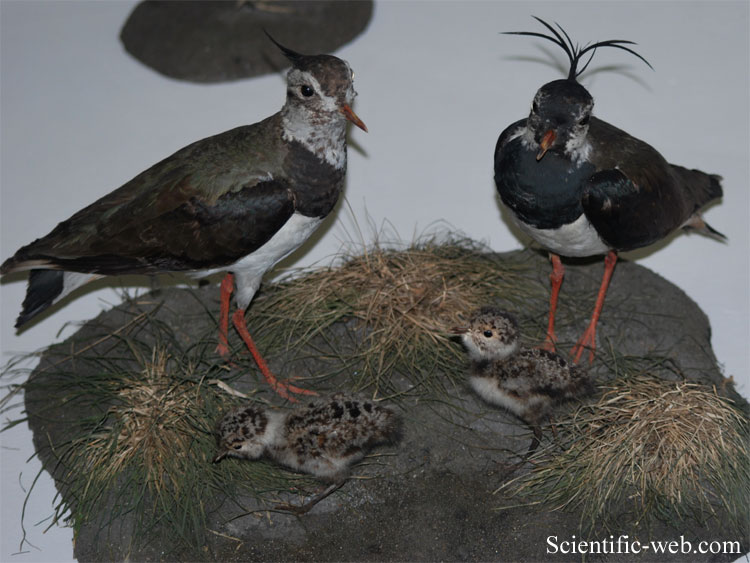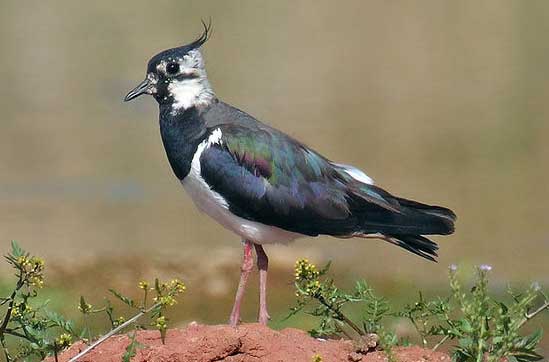
Vanellus vanellus, Photo: Michael Lahanas
Familia: Charadriidae
Genus: Vanellus
Species: Vanellus vanellus
Name
Vanellus vanellus (Linnaeus, 1758)
Synonyms
Tringa vanellus (protonym)

Vanellus vanellus (*)
References
Primary references
Linnaeus, C. 1758. Systema Naturae per regna tria naturæ, secundum classes, ordines, genera, species, cum characteribus, differentiis, synonymis, locis, Tomus I. Editio decima, reformata. Holmiæ: impensis direct. Laurentii Salvii. i–ii, 1–824 pp DOI: 10.5962/bhl.title.542: 148. Reference page.
Vernacular names
Alemannisch: Giritzi
العربية: أبوطيط ذو العرف
asturianu: Cigoreya
azərbaycanca: Buynyzlu cüllüt
žemaitėška: Pīmpė
башҡортса: Тәгәрлек
беларуская: Кнігаўка
български: Обикновена калугерица
brezhoneg: Kornigell gupennek
català: Fredeluga
нохчийн: Kuź bolu h́oza
kaszëbsczi: Cziwùtka
čeština: Čejka chocholatá
чӑвашла: Тĕкĕрлек
Cymraeg: Cornchwiglen
dansk: Vibe
Deutsch: Kiebitz
Ελληνικά: Καλημάνα
English: Northern Lapwing
Esperanto: Tufvanelo
español: Avefría Europea
eesti: Kiivitaja
euskara: Hegabera
فارسی: خروس کولی
suomi: Töyhtöhyyppä
føroyskt: Vípa
Nordfriisk: Liap
français: Vanneau huppé
Frysk: Ljip
Gaeilge: Pilibín
Gàidhlig: Curracag
galego: Avefría
Gaelg: Eairkan
עברית: קוית מצויצת
hrvatski: Vivak
magyar: Bíbic
հայերեն: Սովորական Կիվիվ
íslenska: Vepja
italiano: Pavoncella
日本語: タゲリ
ქართული: პრანწია
қазақша: Қызғыш
한국어: 댕기물떼새
kurdî: Kedîkê bi kofîk
kernowek: Cornwhylen
Lëtzebuergesch: Kiwitsch
lietuvių: Pempė
latviešu: Ķīvīte
македонски: Калуѓерка
മലയാളം: തിത്തിരിപ്പക്ഷി
монгол: Умардын хавтгаалж - ᠣᠮᠠᠷᠠᠲᠣ ᠶᠢᠨ ᠬᠠᠪᠲᠠᠭᠠᠯᠵᠢ
кырык мары: Кӹшедӹк
Malti: Venewwa
эрзянь: Цибирькай
Nedersaksies: Kiefte
Plattdüütsch: Kiewitt
Nederlands: Kievit
norsk nynorsk: Vipe
norsk: Vipe
Nouormand: Pievie
polski: Czajka
Piemontèis: Pavonëtta
پنجابی: ہری ٹٹیری
português: Abibe-comum
rumantsch: Vanel
română: Nagâț
русский: Чибис
sicilianu: Pauneddu nivaloru
Scots: Teuchit
sardu: Lèpiri de argiola
davvisámegiella: Vuoktaláfol
srpskohrvatski / српскохрватски: Vivak pozviždač
slovenčina: Cíbik chochlatý
slovenščina: Priba
shqip: Gicvilja
српски / srpski: Vivak - Вивак
Seeltersk: Kiewiet
svenska: Tofsvipa
Kiswahili: Kiluwiluwi wa Ulaya
ไทย: นกกระแตหงอน
Türkçe: Bayağı kız kuşu
удмурт: Сэдык
українська: Звичайна чайка
vèneto: Pavonzina
Tiếng Việt: Te mào
中文: 凤头麦鸡
The northern lapwing (Vanellus vanellus), also known as the peewit or pewit, tuit or tew-it, green plover, or (in Britain and Ireland) pyewipe or just lapwing, is a bird in the lapwing subfamily. It is common through temperate Eurosiberia.
It is highly migratory over most of its extensive range, wintering further south as far as North Africa, northern India, Nepal, Bhutan and parts of China. It migrates mainly by day, often in large flocks. Lowland breeders in westernmost areas of Europe are resident. It occasionally is a vagrant to North America, especially after storms, as in the Canadian sightings after storms in December 1927 and in January 1966.[3]
It is a wader that breeds on cultivated land and other short vegetation habitats. 3–4 eggs are laid in a ground scrape. The nest and young are defended noisily and aggressively against all intruders, up to and including horses and cattle.
In winter, it forms huge flocks on open land, particularly arable land and mud-flats
Taxonomy
The northern lapwing was formally described by the Swedish naturalist Carl Linnaeus in 1758 in the tenth edition of his Systema Naturae under the binomial name Tringa vanellus.[4] The species is now placed with the other lapwings in the genus Vanellus that was introduced by the French zoologist Mathurin Jacques Brisson in 1760.[5][6] The scientific name Vanellus is Medieval Latin for the northern lapwing and derives from vannus, a winnowing fan.[7] The species is monotypic: no subspecies are recognised.[6]
The name lapwing has been variously attributed to the "lapping" sound its wings make in flight, from the irregular progress in flight due to its large wings (the Oxford English Dictionary derives this from an Old English word meaning "to totter"),[8] or from its habit of drawing potential predators away from its nest by trailing a wing as if broken. The names peewit, pewit, tuit or tew-it are onomatopoeic and refer to the bird's characteristic call.[9]
Description
The northern lapwing is a 28–33 cm (11–13 in) long bird with a 67–87 cm (26–34 in) wingspan and a body mass of 128–330 g (4.5–11.6 oz).[10] It has rounded wings and a crest. It is also the shortest-legged of the lapwings. It is mainly black and white, but the back is tinted green. The male has a long crest and a black crown, throat and breast contrasting with an otherwise white face. Females and young birds have shorter crests, and have less strongly marked heads, but plumages are otherwise quite similar.
This is a vocal bird in the breeding season, with constant calling as the crazed tumbling display flight is performed by the male. The typical contact call is a loud, shrill "pee-wit" from which they get their other name of peewit.[8] Displaying males usually make a wheezy "pee-wit, wit wit, eeze wit" during their display flight; these birds also make squeaking or mewing sounds.
It feeds primarily on insects and other small invertebrates. This species often feeds in mixed flocks with golden plovers and black-headed gulls, the latter often robbing the two plovers, but providing a degree of protection against predators.
Like the golden plovers, this species prefers to feed at night when there is moonlight.
The northern lapwing is one of the species to which the Agreement on the Conservation of African-Eurasian Migratory Waterbirds (AEWA) applies.
Population decline
Chick in the Netherlands
Egg – MHNT
National surveys of England and Wales have shown a population decline between 1987 and 1998, and since 2009 the northern lapwing has had red list conservation status in the United Kingdom.[11] The numbers of this species have been adversely affected by intensive agricultural techniques. In the lowlands this includes the loss of rough grassland, conversion to arable or improved grassland, loss of mixed farms, and switch from spring- to autumn-sown crops. In the uplands, the losses may have been due to increases in grazing density. Natural England gives grant aid to help restore lapwing habitat within its Environmental Stewardship Scheme. The organisation suggests an option within this scheme called 'Fallow plots for ground-nesting birds'. Uncropped plots at least 2 ha (4.9 acres) in size provide nesting habitat and are located in suitable arable fields, which provide additional foraging habitat. Locating the plots within 2 km (1.2 mi) of extensively grazed grassland will provide additional foraging habitat. The plots are cultivated in the spring to produce a rough fallow, which is retained without the input of fertiliser or pesticides.[12] In addition to agricultural intensification and land-use change, predation of nests and chicks contributes to wader declines, including of lapwing. By radio-tagging lapwing chicks, and using automatic radio tracking systems, the timing of chick predation can be revealed, which provides additional insights in to the importance of different predators. Lapwing chicks are predated both in the day and at night, with mammalian predators having the greatest impact.[13]
In Armenia, the population decline and loss of breeding habitats was also documented; the threats are thought to be intensification of land use and hunting, but further investigations for threat clarification are required.[14]
Cultural significance
Lapwing incubating its eggs - A photograph for which in 1895 R. B. Lodge received from the Royal Photographic Society the first medal ever presented for nature photography. Eric Hosking and Harold Lowes stated their belief that this was the first photograph of a wild bird.[15]
Harvesting eggs
"Plover's eggs" were an expensive delicacy in Victorian Europe, mentioned in Evelyn Waugh's Brideshead Revisited, about aristocratic British society in 1920–40. In the Netherlands, there is a cultural-historical competition to find the first peewit egg of the year (het eerste kievietsei). It is especially popular in the province Friesland, but there are also regional competitions. Gathering peewit eggs is prohibited by the European Union, but Friesland was granted an exception for cultural-historical reasons. The Frisian exception was removed in 2005 by a court, which determined that the Frisian executive councillors had not properly followed procedure.[16][17] As of 2006 looking for peewit eggs is permitted between 1 March and 9 April, though harvesting the eggs is now forbidden. In 2008 the first egg was found on 3 March, in Eemnes, Utrecht,[18] and the first egg of 2009 was found on 8 March in Krabbendijke.[19] Over the last century, the first peewit egg has been found earlier and earlier in the year. This is ascribed to both increased use of fertiliser and climate change, causing the growth of grass needed for egg laying to occur earlier.[20]
Mythology
The bird referred to in English translations of Ovid's Metamorphoses, book 6, as lapwing[21] is probably the northern lapwing. Tereus is turned into an epops (6.674); Ovid presumably had the hoopoe in mind, whose crest indicates his royal status and whose long, sharp beak is a symbol of his violent nature.
In Ireland
King Philip II with a feather in his cap.
The northern lapwing was declared the Republic of Ireland's national bird by a committee of the Irish Wildlife Conservancy in 1990.[22][23][24] In the Irish language it is called pilibín, "little Philip", supposedly a reference to Philip II of Spain (King of Ireland 1554–58), who often wore a feather in his cap.[25]
References
BirdLife International (2017) [amended version of 2016 assessment]. "Vanellus vanellus". IUCN Red List of Threatened Species. 2017: e.T22693949A111044786. doi:10.2305/IUCN.UK.2017-1.RLTS.T22693949A111044786.en. Retrieved 15 January 2018..
"Vanellus vanellus (Linnaeus, 1758) – Northern Lapwing". Species Inventory. The Natural History Museum. Retrieved 1 April 2020.
Godfrey, W. Earl (1986). The Birds of Canada (Revised ed.). National Museum of Natural Sciences. p. 179. ISBN 978-0-660-10758-5.
Linnaeus, Carl (1758). Systema Naturae per regna tria naturae, secundum classes, ordines, genera, species, cum characteribus, differentiis, synonymis, locis (in Latin). Volume 1 (10th ed.). Holmiae (Stockholm): Laurentii Salvii. p. 148.
Brisson, Mathurin Jacques (1760). Ornithologie, ou, Méthode Contenant la Division des Oiseaux en Ordres, Sections, Genres, Especes & leurs Variétés (in French and Latin). Paris: Jean-Baptiste Bauche. Vol. 1, p. 48, Vol. 5, p. 94.
Gill, Frank; Donsker, David; Rasmussen, Pamela, eds. (July 2021). "Sandpipers, snipes, coursers". IOC World Bird List Version 11.2. International Ornithologists' Union. Retrieved 22 November 2021.
Jobling, James A (2010). The Helm Dictionary of Scientific Bird Names. London: Christopher Helm. p. 397. ISBN 978-1-4081-2501-4.
"Lapwing". Oxford English Dictionary (Online ed.). Oxford University Press. (Subscription or participating institution membership required.)
"Peewit". Dictionary.com. Retrieved 2 February 2018.
"Northern Lapwing Vanellus vanellus". oiseaux-birds.com. Retrieved 1 April 2020.
"Lapwing Vanellus vanellus". Breeding Birds in the Wider Countryside. British Trust for Ornithology. Retrieved 1 April 2020.
"Lapwings thrive on fallow plots". BTO News (269): 17. March–April 2007.
Mason, L. R.; Smart, J.; Drewitt, A. L. (2018). "Tracking day and night provides insights into the relative importance of different wader chick predators". Ibis. 160 (1): 71–88. doi:10.1111/ibi.12523.
"Northern Lapwing Vanellus vanellus in Armenia". Armenian Bird Census, TSE NGO].
Eric Hosking; Harold Lowes (1947), Masterpieces of Bird Photography, William Collins, Sons, p. 9, ASIN B000O8CPQK, Wikidata Q108533626
Walinga, Ruurd (17 March 2005). "Dertig jaar juridische strijd om kievitseieren" [Thirty year legal battle for plover's eggs] (in Dutch). Friesch Dagblad. Retrieved 19 February 2009.
Stichting De Faunabescherming and Nederlandse Vereniging tot bescherming van Vogels vs. het college van gedeputeerde staten van Fryslân, LJN: AT0660, Rechtbank Leeuwarden, 03/518 BESLU & 03/547 BESLU (Rechtbank Leeuwarden 16 March 2005).
"Eerste kievitsei van 2008 gevonden" [First plover egg of 2008 found] (in Dutch). Nederlandse Omroep Stichting. 3 March 2008. Archived from the original on 10 March 2008. Retrieved 19 February 2009.
"Dutch spring heralded by lapwing egg". Radio Netherlands / Equi Parvi. 8 March 2009. Retrieved 9 March 2009.
"Vinddatum eerste kievitsei in Friesland" [Dates of Discovery of the First Plover's Eggs in Friesland] (in Dutch). Milieu & Natuurcompendium. 6 June 2008. Retrieved 19 February 2009.
Garth, Sir Samuel; Dryden, John; et al. "'Metamorphoses' by Ovid".
Reilly, Jerome (23 October 2016). "Lapwing's tricolour feathers fit the bill". Irish Independent. Retrieved 1 April 2020.
"National Bird of Ireland – Northern Lapwing – Light Future Art".
Egan, James. 1000 Facts About Ireland. Lulu.com. ISBN 9780244110734 – via Google Books.
Fitzgerald, Ann (25 March 2017). "Opinion: Connecting with nature a sure-fire way to bolster your wellbeing". Farming Independent. Retrieved 1 April 2020.
Retrieved from "http://en.wikipedia.org/"
All text is available under the terms of the GNU Free Documentation License

